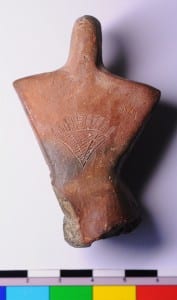Figure of the Moment
By Alice Stevenson, on 4 June 2014
Predynastic Egyptian figurine UC9601 is very much in demand right now. She has just finished a stint as the poster girl for the Petrie Museum’s A Fusion of Worlds exhibition. Now this petite, 6.6 cm-high pottery statuette is on her way to the Centre Pompidou-Metz, France where she will feature in the international exhibition Simple Shapes, alongside works by Barbara Hepworth, Pablo Picasso and Henry Moore.

UC9601, Egyptian figurine dating to c.3600 BC. Excavated from the surface of cemetery 100 at Qau in the early 1920s.
Diminutive, stylized and anonymous human figurines like UC9601 are evocative and enigmatic. As Debbie Challis and Gemma Romain recently explored in their exhibition A Fusion of Worlds, modernist artists in the 1910s–30s, such as Jacob Epstein, were drawn to visual culture like this, perceiving them to be powerful symbols of religion, fertility or with reference to some universal ‘Earth Mother Fertility Goddess’. As these ancient forms echoed within and beyond the modernist art movement they became ‘timeless’. It is this quality that recently drew the Art Directors of the US television hit True Blood to the Brooklyn Museum of Fine Arts’ own Predynastic ‘bird-lady’ figurine as prop in an episode of the supernatural drama. They are as captivating now and as I think they would have been 5500 years ago.

Predynastic Figurine found in a grave at Ma’amerieh, now in the Brooklyn Museum of Fine Arts. 07.447.505
Archaeological consideration of prehistoric figurines is a burgeoning area of scholarship, so much so that there is a new Oxford University Press handbook devoted to this topic currently being compiled, to be published in 2015. I had the opportunity to explore the figurine literature as a contributor to this volume and I found myself enthralled by these miniature sculptures and the myriad of novel approaches to their interpretation and modern presentation (one of my favourites was the Unearthed exhibition).
One of the first archaeological works devoted to examining Egyptian Predynastic figurines was Peter Ucko’s 1968 book Anthropomorphic Figurines and it includes many examples now in the Petrie Museum.

Not all Predynastic Egyptian figurines are female. This example from the Petrie Museum collection was excavated from tomb U96 Abadiyeh in 1898.
Not all of the figurines Ucko’s corpus are as graceful as Brooklyn’s so-called ‘bird lady’ or the Petrie’s cover girl. Some are rough, stocky and obese, like the ones excavated by Petrie’s teams at Naqada.

Two Predynastic Egyptian figurines excavated by Petrie’s teams at Naqada 1894-1895. This negative is in the Petrie Museum archive (PMAN2632), but the objects are now in the Ashmolean, Oxford.
Yet very few Predynastic Egyptian figurines have in fact been excavated. More than half of the examples in Ucko’s catalogue are unprovenanced and fifty years later, only a small number of examples have since been recovered during fieldwork. It leaves a question mark of authenticity above many so-called Predynastic figurines.
Looking across World Archaeology more broadly, the rarity of hand-modelled Egyptian figurines in the 4th millennium BC becomes even more stark. In many prehistoric societies three-dimensional human forms were fairly ubiquitous. Just look at the corpuses of material from Çatalhöyük, the Indus Valley, Mesoamerica or Japan. Is the dearth of Egyptian examples therefore just a product of poor preservation or excavation deficiencies? I don’t think so. Their numbers are so low as to demand other explanations. Figuring absence is as important as figuring meaning.
But I am actually less interested in what these figurines meant or symbolized, than I am in how these things might have been meaningful to past communities. A large part of the academic literature on such artefacts takes an art historical, visual approach to analysing their form, function and ‘meaning’, often paying scant regard for the contexts in which these objects were found or used. Other studies have taken a different tack. One that I find provocative, especially considering UC9601, really gets to the grips with these puzzling pieces: it considers the tactile, material qualities of figurines (see, for example, the work of Doug Bailey). This is important because these miniatures invite intimate manipulation and, as I explore more fully in my OUP handbook contribution, moments of making were an integral part of how they had meaning.
As a curator I am very privileged to be able to readily access some of Egypt’s earliest anthropomorphic sculptures and experience them for myself in my (albeit gloved) hand. UC9601 has been in many hands over the last century, but there is a trace on this little relic of an even more ancient one. If you look closely at the side of her head, the unmistakable contours of single fingerprint are visible: that of her ancient creator. And as I cradle her in my palm that timelessness really does echo.

An object handled in many times and places. The excavator’s marks (23/100) from AD 1923, above which is the museum’s accession numner from c. AD 1960, and finally above that is the creator’s mark from c. 3650 BC.
 Close
Close



